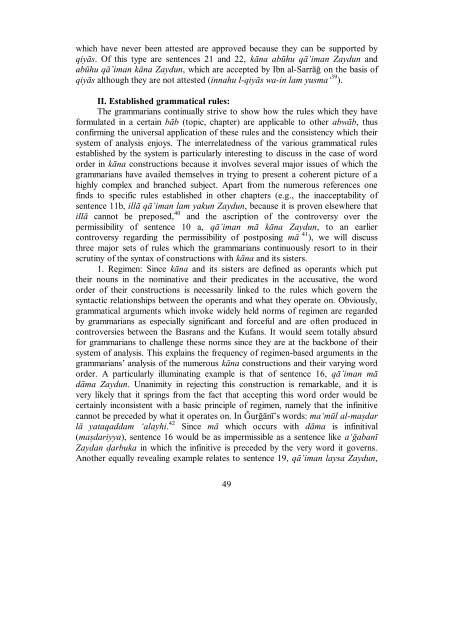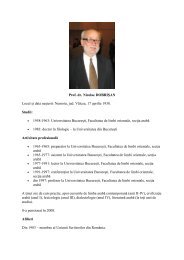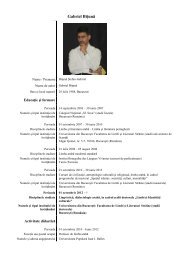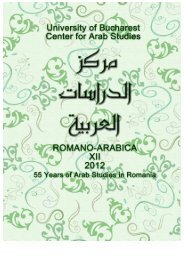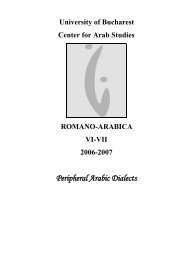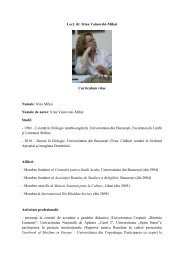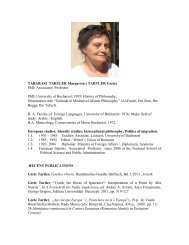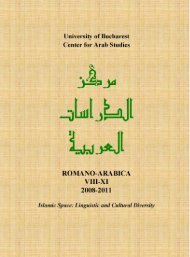Arabic Linguistics
Arabic Linguistics
Arabic Linguistics
You also want an ePaper? Increase the reach of your titles
YUMPU automatically turns print PDFs into web optimized ePapers that Google loves.
which have never been attested are approved because they can be supported by<br />
qiyās. Of this type are sentences 21 and 22, kāna abūhu qā‟iman Zaydun and<br />
abūhu qā‟iman kāna Zaydun, which are accepted by Ibn al-Sarrāğ on the basis of<br />
qiyās although they are not attested (innahu l-qiyās wa-in lam yusma„ 39 ).<br />
II. Established grammatical rules:<br />
The grammarians continually strive to show how the rules which they have<br />
formulated in a certain bāb (topic, chapter) are applicable to other abwāb, thus<br />
confirming the universal application of these rules and the consistency which their<br />
system of analysis enjoys. The interrelatedness of the various grammatical rules<br />
established by the system is particularly interesting to discuss in the case of word<br />
order in kāna constructions because it involves several major issues of which the<br />
grammarians have availed themselves in trying to present a coherent picture of a<br />
highly complex and branched subject. Apart from the numerous references one<br />
finds to specific rules established in other chapters (e.g., the inacceptability of<br />
sentence 11b, illā qā‟iman lam yakun Zaydun, because it is proven elsewhere that<br />
illā cannot be preposed, 40 and the ascription of the controversy over the<br />
permissibility of sentence 10 a, qā‟iman mā kāna Zaydun, to an earlier<br />
controversy regarding the permissibility of postposing mā 41 ), we will discuss<br />
three major sets of rules which the grammarians continuously resort to in their<br />
scrutiny of the syntax of constructions with kāna and its sisters.<br />
1. Regimen: Since kāna and its sisters are defined as operants which put<br />
their nouns in the nominative and their predicates in the accusative, the word<br />
order of their constructions is necessarily linked to the rules which govern the<br />
syntactic relationships between the operants and what they operate on. Obviously,<br />
grammatical arguments which invoke widely held norms of regimen are regarded<br />
by grammarians as especially significant and forceful and are often produced in<br />
controversies between the Basrans and the Kufans. It would seem totally absurd<br />
for grammarians to challenge these norms since they are at the backbone of their<br />
system of analysis. This explains the frequency of regimen-based arguments in the<br />
grammarians‘ analysis of the numerous kāna constructions and their varying word<br />
order. A particularly illuminating example is that of sentence 16, qā‟iman mā<br />
dāma Zaydun. Unanimity in rejecting this construction is remarkable, and it is<br />
very likely that it springs from the fact that accepting this word order would be<br />
certainly inconsistent with a basic principle of regimen, namely that the infinitive<br />
cannot be preceded by what it operates on. In Ğurğānī‘s words: ma„mūl al-mas}dar<br />
lā yataqaddam „alayhi. 42 Since mā which occurs with dāma is infinitival<br />
(mas}dariyya), sentence 16 would be as impermissible as a sentence like a„ğabanī<br />
Zaydan d}arbuka in which the infinitive is preceded by the very word it governs.<br />
Another equally revealing example relates to sentence 19, qā‟iman laysa Zaydun,<br />
49


